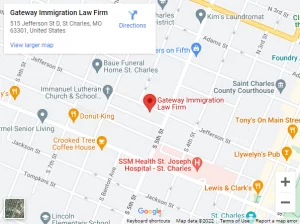Get help from an immigration attorney on Asylum and Refugee status application procedures
If you or a loved one have faced persecution in your home country or have been threatened with persecution, you may be eligible to remain in the US through asylum status. People who are given asylum or refugee status in the United States receive special legal protections so that they need not return to the country where they faced persecution
Seek out a St. Charles immigration attorney at Gateway Immigration Law Firm to know what are the procedures for applying for asylum and refugee status in the United States. Our Missouri immigration attorneys are always happy to answer questions about immigration law. Talk to us today!
What is Asylum?
Asylum is a legal status used in US immigration law. When a person has asylum in the US, they are allowed to remain in the country so they are protected from persecution in their home countries.
You may be eligible for asylum if you enter or request entry into the United States and apply for protection. If the US grants you asylum, you do not have to return to your home country. You must demonstrate that you are a refugee who is unable or unwilling to return to your country of nationality due to persecution or a well-founded fear of persecution because of your race, religion, nationality, membership in a particular social group, or political opinion to be eligible for asylum as asylum seekers.
You may only file an asylum application if you are physically present in the United States and you are not a US citizen. In case you missed it, during the administration of former president Trump, they attempted to undo this law by creating a policy called ‘Remain in Mexico’ or the Migrant Protection Protocols (MPP). Meanwhile, the Biden administration sought to undo the MPP and finally got the go-ahead from the Supreme Court in June of 2022.
Definition of Terms: What is Refugee vs Asylum Seeker?
A refugee is an individual fleeing the risk of persecution or serious harm, including human rights violations, armed conflict, or persecution. The risks to their safety and life were tremendous they felt they had no choice but to leave and seek safety outside their country because their government could not or would not protect them from those dangers. Refugees have a right to international protection.
An asylum seeker is someone who has left their country and is seeking protection from persecution and serious human rights violations in another country. Individuals who have already made it to the U.S. border or the interior (perhaps by using a visa or by entering illegally) can, in theory, apply for asylum status. Seeking asylum is a human right. This means everyone should be allowed to enter another country to seek asylum.
Who is Eligible for Asylum or Refugee Status?
Asylum and refugee status are special legal protections available to people who have left their home country for safety and are afraid to return to any place within their homeland.
The difference between asylum and refugee status under US immigration law is who seeks asylum status and who should seek refugee status. It is simply a matter of where you are when you apply.
People outside the US must apply for refugee status, typically through the UN High Commission for Refugees. (They cannot specify that they would like to go to the US or any particular country, however.) People who have already made it to the US border or the interior (perhaps by using a visa or by entering unlawfully) can apply for asylum status.
Once individuals are permitted either refugee or asylee status, they can stay in the United States indefinitely. Asylees and refugees are permitted to work and can apply for a green card within one year of either entering the US as a refugee or being approved for asylum.
What are the Ways to Obtain Asylum in the United States?
There are three ways of obtaining asylum in the United States:
- The affirmative process;
- An Asylum Merits an Interview after a positive credible fear determination; or
- The defensive process.
Affirmative Asylum Processing with US Citizenship and Immigration Services (USCIS)
You must be physically available in the United States to apply for asylum through the affirmative asylum process. Regardless of how you entered the country or your present immigration status, you can petition for asylum.
You must apply for asylum within a year of the date of your most recent entry into the country unless you can demonstrate:
- Unusual circumstances connected to the delay in filing or changed circumstances that materially impair your eligibility for asylum; and
- You filed within a reasonable amount of time, given those circumstances.
You may apply for affirmative asylum by submitting Form I-589, Application for Asylum and Withholding of Removal, to USCIS. Please see the Affirmative Asylum Process for step-by-step information on applying for asylum through the affirmative asylum process.
Asylum Merits Interview with USCIS After a Positive Credible Fear Determination
You will be referred to USCIS for a credible fear screening if you are placed in expedited removal proceedings and state that you intend to seek asylum, express a fear of torture or persecution or state that you fear returning to your home country.
To ascertain if you have a reasonable fear of being persecuted or subjected to torture, a USCIS asylum officer will interview you. If an asylum officer determines that you have a justifiable fear of being persecuted or subjected to torture, the USCIS may:
- Retain and consider your asylum application, your eligibility for protection under the Convention Against Torture (CAT), and the withholding of removal in a subsequent interview called an Asylum Merits Interview. You will be evaluated for asylum eligibility by an officer. If required, an asylum officer will also decide whether your record before USCIS shows you meet the requirements for CAT protection or withholding of removal; or
- Send out a notice to appear before an immigration judge to discuss your claims for CAT protection, withholding of removal, and asylum. You enter the ‘defensive’ asylum process after submitting Form I-589 to the immigration court.
Defensive Asylum Processing with the Executive Office for Immigration Review (EOIR)
When you apply for asylum to prevent being deported from the US, this is known as a defensive application. You must be the subject of removal proceedings before an immigration judge through the EOIR for the asylum processing to be launched.
One of two methods is typically used to place people into defensive asylum processing:
- USCIS refers them to an immigration judge after determining they are ineligible for asylum after the affirmative asylum process; or
- They are subject to removal procedures as a result of:
- Being detained in the country or at a port of entry without valid identification or in breach of their immigration status;
- Being captured by the Americans Borders and Customs and Border Protection (CBP) trying to enter the US illegally, placed in the expedited removal process, and found to have a credible fear of persecution or torture by an asylum officer.
Applying for asylum is not an easy process. The forms you fill out are just the beginning—the key is putting together a convincing account of what happened to you and being able to stand up to questioning by an immigration officer (and potentially an immigration judge).
It is best to hire an immigration attorney to guide you on the procedures for applying for asylum and refugee status. Contact our St. Charles immigration attorney at Gateway Immigration Law.
What is Persecution?
Few of the numerous asylum seekers fall into that category. Persecution is broadly defined as the infliction of pain or harm, or a serious threat to your life or liberty. Death threats, torture, imprisonment, constant surveillance, pressure to join a group engaging in illegal activity, interference with your privacy, family, home, or correspondence, or discrimination in matters such as housing, education, or passport issuance have all been found to qualify.
Furthermore, economic hardship is not considered a sufficient reason for granting refugee or asylum status. It is also insufficient if someone harbors a grudge against you or has committed crimes against you for arbitrary or personal reasons.
Even if you have not previously experienced persecution, you may be eligible for political asylum or refugee status if you have a genuine fear of future persecution in your home country or last country of residence. For example, if you were the secretary of a student dissident group and undercover agents sent you death threats or murdered your group’s treasurer and president, you could most likely demonstrate a reasonable fear of persecution.
Can I File for Permanent Residence (Green Card)?
The answer is YES. After a year of being granted asylum, you may apply for a green card. To apply for permanent residence, file Form I-485, Application to Register Permanent Residence, or to Adjust Status. You must submit a separate Form I-485 application packet for yourself and, if applicable, for each family member who received derivative asylum based on your application.
Ask our St. Charles Immigration Attorney Today!
The procedure for applying for asylum and refugee status is a complex process. It can be taxing to file various forms, as well as convince and stand up to questions from an immigration officer or judge. Seeking assistance from a St. Charles immigration attorney would be advantageous for one. Our lawyers at Gateway Immigration Law firm are always ready to help you with your immigration status concerns.
For over 15 years, we have served a thousand Missouri residents with their legal concerns. Our Missouri immigration attorneys are ready to help you apply for a green card, become a US citizen, and more.
What are you waiting for? Start your immigration journey and schedule a consultation with us today!







